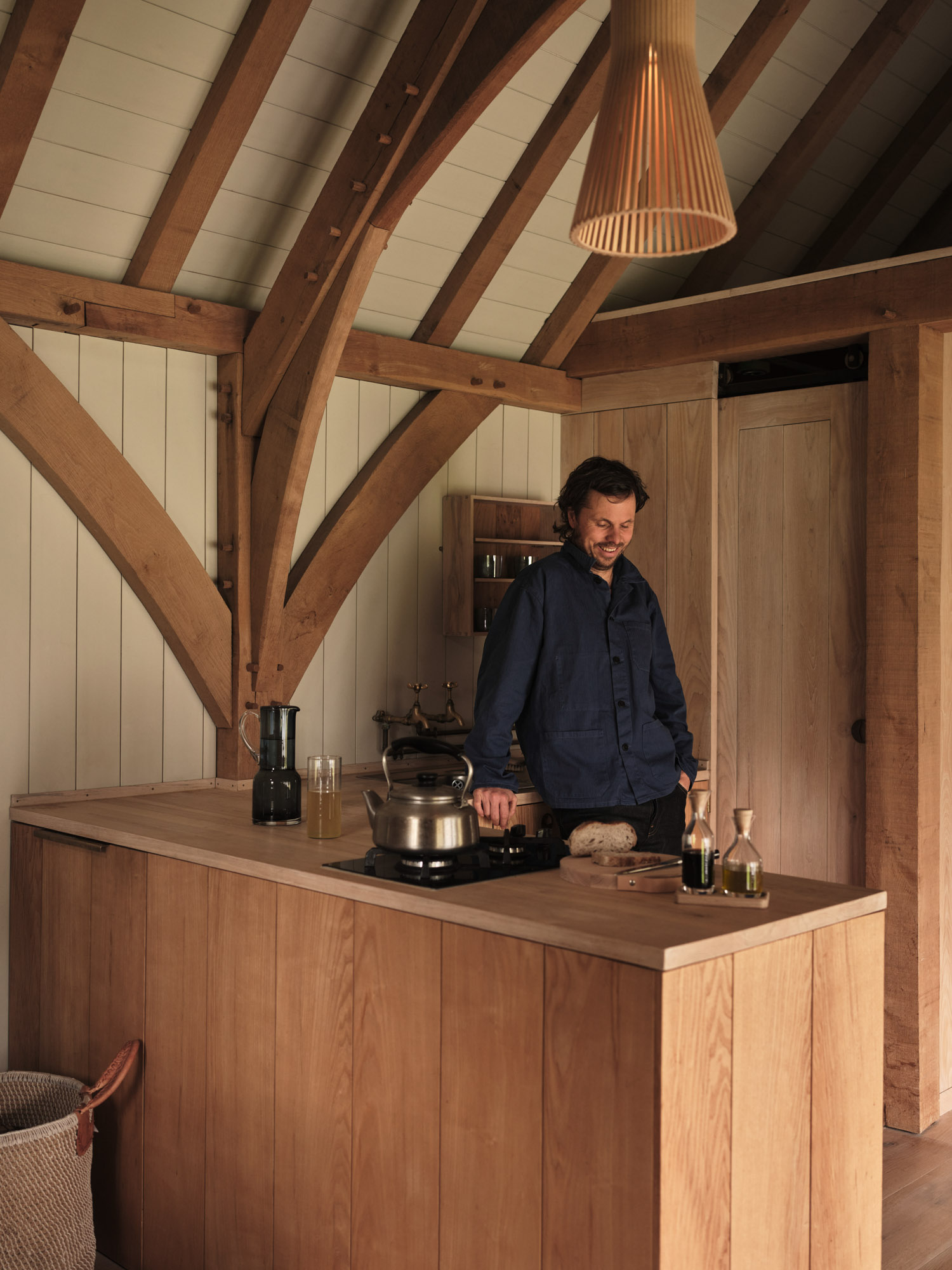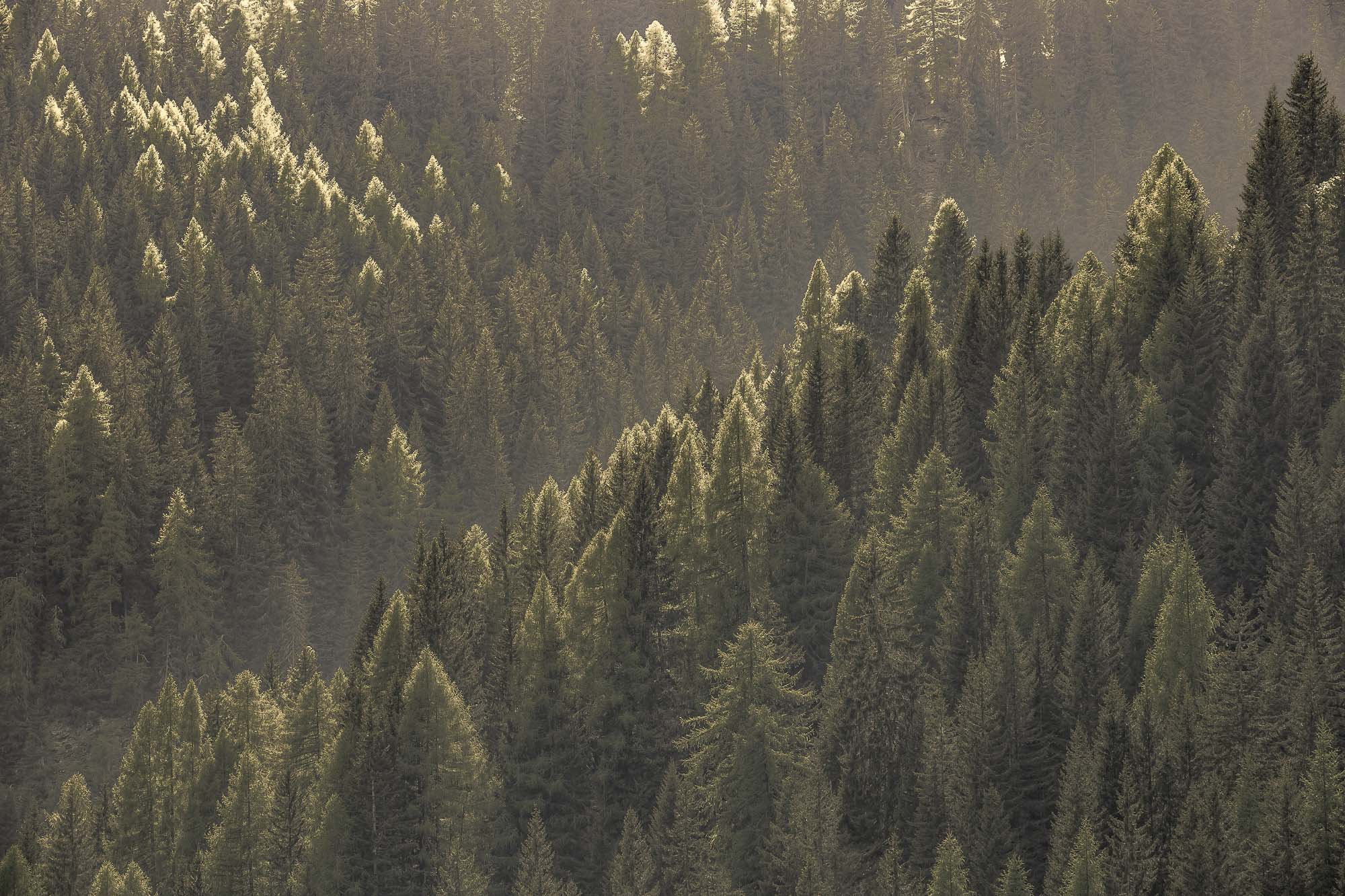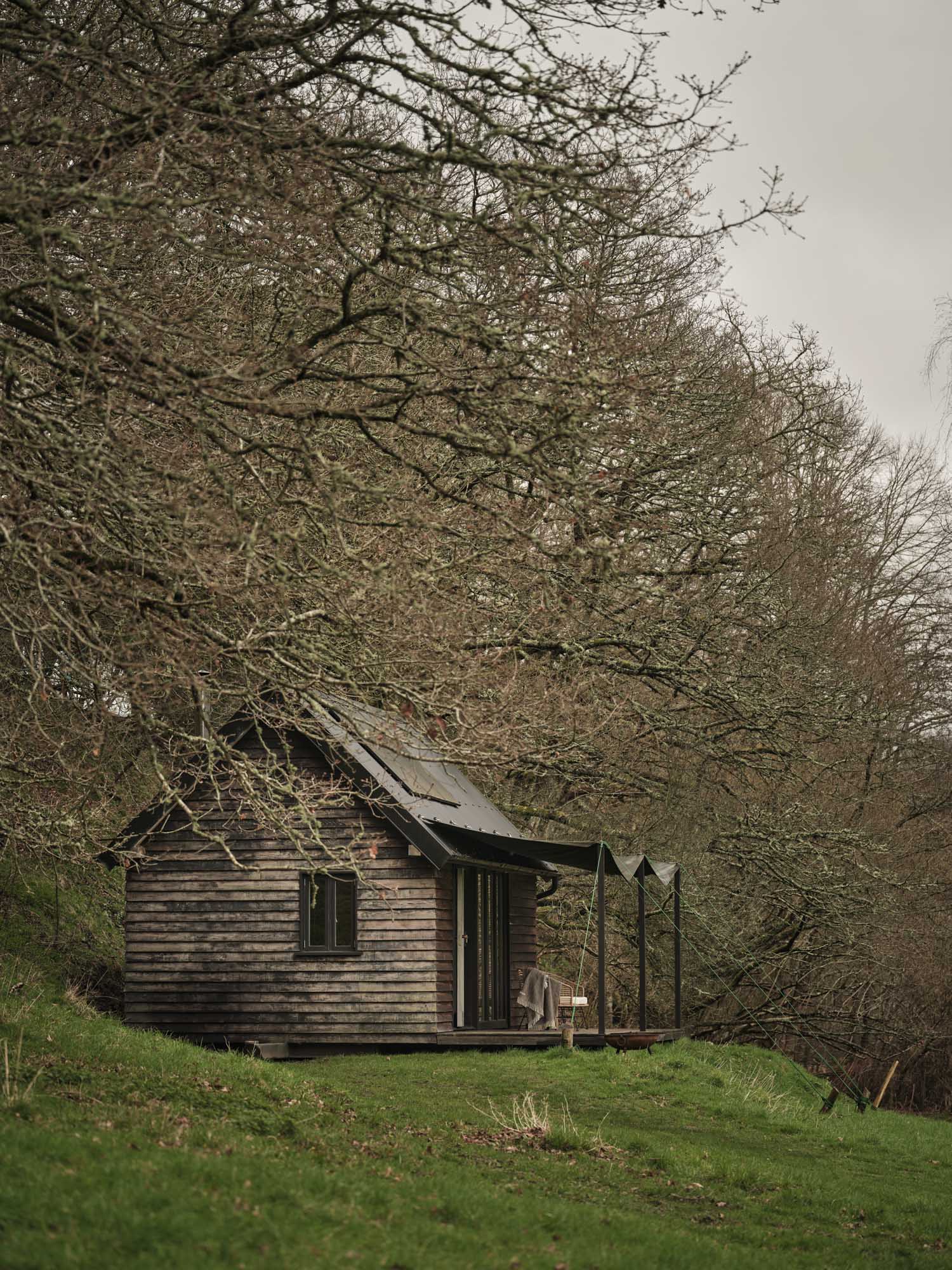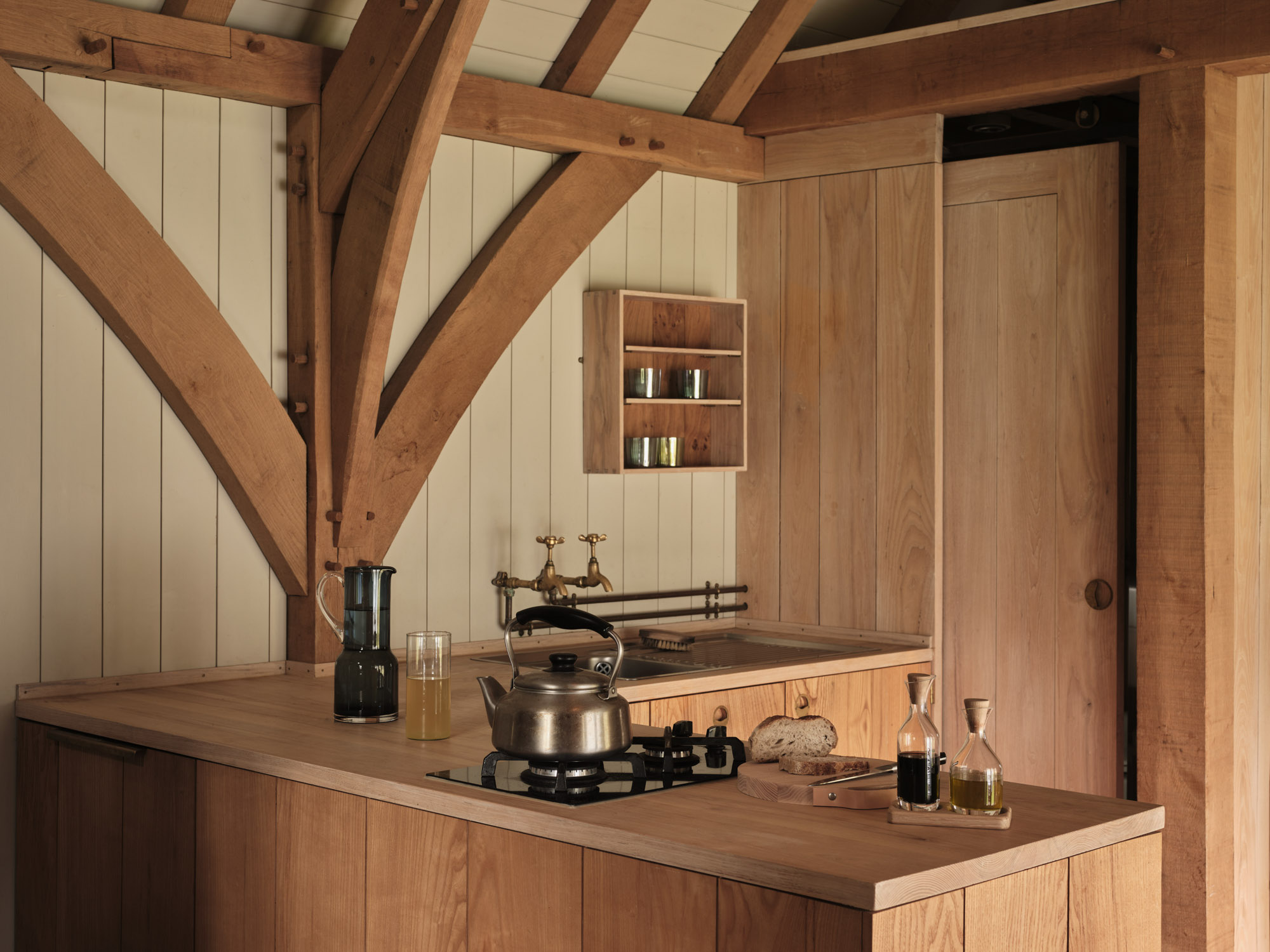Designs that Connect to Environment


Rupert McKelvie’s life has been shaped by nature, from his childhood spent exploring the English countryside to his current venture, Out of The Valley (OOTV), which creates outdoor cabins and saunas in natural, sustainable materials. The project started as a practical labour of love; his very first Oak cabin became his home, built in a deep valley on the edge of Dartmoor, giving the newfound architecture practise its rightful name. After gaining traction at London Design Week, it wasn’t long before people around him felt a resonation for the same off-grid lifestyle, set against a backdrop of rural expanse.
His cabins today are still consciously designed and crafted, and wooden prefabricated saunas look out across rolling forests and wild landscapes. We speak on a crisp February morning, considering locality, seasonality and the longing for a life with less ‘stuff’.
What are your memories of growing up?
I grew up in Gloucestershire’s countryside surrounded by farms and woodlands. My mother and father had bought a farmhouse in the late 70’s, more of a ruin than a house. It was in a beautiful setting on its own, by a small river.
There was only one room that didn’t have water leaking into it, so over the next twenty years it was gradually restored using traditional materials and techniques. My father turned one of the barns into his carpentry workshop. I spent many hours of my childhood sweeping up sawdust and making objects with bits of wood. When I got home from school I’d chuck on some old clothes and see how I could help out, there was always log splitting to be done and when one of his pieces of furniture was near completion I’d help by rubbing oil onto the surface.
Nature was a big part of growing up. I spent a lot of time outside. My mother loves gardening and animals. One spring morning my father returned from a walk with an injured deer that had caught her leg in a fence. We looked after her while her leg healed and she joined the family, eating out of dog bowls with our collies and following us on walks. Even though she could have left for the woods she always came back, we named her Acorn after the Oak tree she was found under.

You have a background as a wooden boat builder, what did this teach you?
My godfather lived in Devon not far from the River Dart, from the age of 12 I would travel down at the start of the summer to stay with him. The highlight was going out on the water on his old venetian speedboat and wooden launch, it sparked a love of the ocean.
After college I enrolled on a classical boat building course in Dorset. We started by making a dovetailed tool box, then moved into the theory and practicalities of lofting – the process of taking a boat design on paper and turning it into full scale patterns. From these we shaped planks into hulls, stems and transoms, carved oars and steam-bent ribs. It taught me how to make more fluid forms and to understand the nature of different types of wood.
There are some similarities to what Out of the Valley does now, in creating structures to protect against the elements, whilst using the warmth of wood to create welcoming spaces. Spaces you want to spend time in.
What made you leave London for a life in Dartmoor?
I’m happier in more isolated places and I like living where I can run, swim and surf. I studied design at Falmouth School of Art, I then moved to London to work in the design and manufacturing of furniture. I would often return to Devon and after a few years converted a barn into a workshop on a small rural farm.
“The place inspired the work, and it really did come out of the valley and into the world.”

How did OOTV come to be?
It came about quite naturally, I needed somewhere to live. I decided to turn my hand to building my own wooden cabin. I used the weekends and evenings to make it alongside other work, it was the inspiration for much of what we have done since.
Beyond the practical need of somewhere to live, what were your motivations for building a remote home for yourself?
I wanted to set myself a challenge in building a small home, one that was made using natural materials and traditional timber framing techniques. Because the cabin was for myself I could explore my ideas freely, I wanted to make something that would be comfortable to live in year round, cheap to run, small enough to be moved and made exclusively of non toxic materials.
“The cabin is cosy, it’s an intimate space and has everything that you need at arms reach. There is less clutter and it is noticeable that you enjoy your time there as a result, I find that I read and draw more when I’m there.”
What about the materials you use, and the importance of how they are sourced?
Buildings require a lot of materials in their construction, Out of the Valley aims to keep that to a minimum by reducing complexity and waste. We source what we can locally and from the UK. The materials we use are non toxic, from the formaldehyde free sheet materials, to the insulation, paints and finishes . We aim to make healthy, breathable buildings that touch lightly on the land and their inhabitants.
When it comes to installing our buildings we opt for screw piles, as the name suggests these are large steel screws that are driven into the ground. They alleviate the need for concrete and can be removed if ever the sauna or cabin were to be relocated.
How do you embrace new technologies and ways of working?
With Out of the Valleys new line of saunas we’re constantly testing and researching our designs. We’ve developed an internal ventilation system that remains largely hidden but does the important work of moving condensation away from the vapour barrier and out to the atmosphere. We focus on a lot of the details you don’t see, which means that the details you do see will last.
We pay attention to the seamless junctioning of materials and surfaces, along with proportion and aesthetics. Everything happens under one roof – from the design to the production.
There are a lot of exciting new materials and interesting products coming into the construction sector, replacing the old oil-based equivalents. Bio materials can be taken from the waste stream of commercial processes such as straw stalks from cereal production or they are grown. Hemp is a good example of a fast growing plant that locks away carbon whilst having incredibly strong fibres. This is made into boards, bricks and insulation amongst other things. Mycelium is being grown into panels to create insulation with thermal and acoustic qualities and cork turned into cladding and even bricks. There are a lot of developments in this area and we’re excited for what they can bring to our projects.
“I think everyone has a desire to return to something simpler ”that you enjoy your time there as a result, I find that I read and draw more when I’m there.”
Why do you think there are more and more people interested in living off grid, with a connection to nature?
More people are starting to bring off grid technologies into their homes, namely solar panels to supplement energy consumption. How and where food is grown is also being discussed a lot more, which in turn has hopefully led to an increasing amount of people growing their own. There are few who live truly ‘off-grid’ as it requires a lot of time and energy – it’s hard work. Anything we can do is a good thing, whether it’s composting, recycling grey water or installing a wind turbine.
What has been your most memorable project so far?
We’ve taken on some really ambitious projects, especially in the early years, we always wanted to say yes. We took on an old boat house on the South Coast, it was on a little rocky beach that you couldn’t drive to. On a good day, and if it wasn’t wet, you could get to the top of the cliff. It was incredibly steep, and we had to carry the materials down to the beach by hand. Building in remote places is certainly challenging, but that’s the whole point of it.
Photography: Jakob Powell